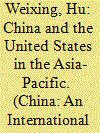| Srl | Item |
| 1 |
ID:
159763


|
|
|
|
|
| Summary/Abstract |
This article presents an analysis of South Korea’s strategic choices over the Asian Infrastructure Investment Bank (AIIB), the Trans-Pacific Partnership (TPP), and the Terminal High Altitude Area Defense (THAAD) in light of the Sino–US competition in post-Cold War East Asia. South Korea’s puzzling behavior here represents Seoul’s hedging strategy against the uncertain future of the Sino–US competition in East Asia. The driving force of South Korea’s hedging behavior is Seoul’s dual concerns about being excessively dependent on the USA for its security at the time of China’s rapid rise on the one hand and being pulled into a growing China’s sphere of influence at the expense of traditional US–ROK security ties on the other. Reflecting Seoul’s prudent balancing acts between the two superpowers, South Korea’s hedging often results in apparently indecisive and underdetermined strategic choices in the face of the intensifying Sino–US competition. Nevertheless, South Korea’s hedging strategy allows Seoul to deepen extensive economic ties with Beijing while maintaining a traditional security alliance with Washington. The hedging behavior of South Korea, which is uniquely positioned as a strategic partner of rapidly rising China as well as a key security ally of the rebalancing USA, sheds important light on the behavior of middle powers in alliance politics, which has largely been neglected in the current literature.
|
|
|
|
|
|
|
|
|
|
|
|
|
|
|
|
| 2 |
ID:
152277


|
|
|
|
|
| Summary/Abstract |
The relationship between China and the United States is one between a rising power and an established power. Whether China is a revisionist power or a status quo power depends on how China and the United States get on with one another in the Asia-Pacific region. The US pivot to Asia and China’s rapid rise has created new dynamics for China–US relations in the region. A changing China–US relationship is also reshaping the strategic landscapes in the Asia-Pacific. US policy towards China has oscillated between containment and engagement since the end of the Cold War. In recent years, this policy has increasingly focused on the “engage but hedge” logic. The Obama administration’s pivot to Asia has rebalanced the focus of the “engage but hedge” policy and put more emphasis on political, economic and security competition with China in the Asia-Pacific region. Despite Xi Jinping’s proposal for a “new model of major power relations” between China and the United States, both countries are actually entering into a “new normal” type of power rivalry in the Asia-Pacific region.
|
|
|
|
|
|
|
|
|
|
|
|
|
|
|
|